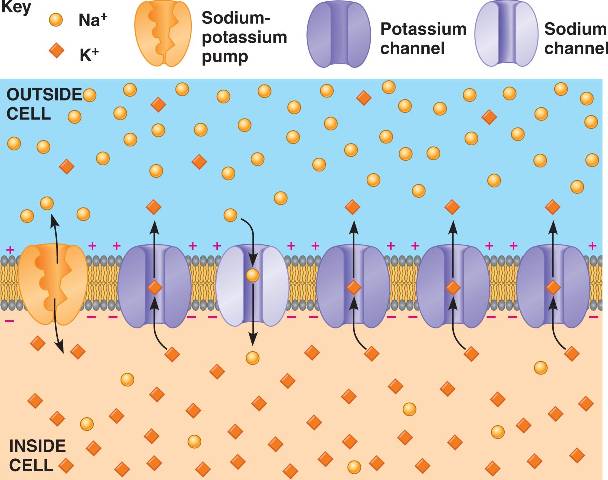Membrane potential
Membrane potential (also known as membrane voltage or transmembrane potential) is the difference in the electrical potential between interior and exterior of a biological cell. The usual values of membrane potential ranges from –40 mV to –80 mV. The voltage begins from differences in concentration of the electrolyte ions K+ and Na+. When the cell membranes were simply permeable to these ions, they would approach equilibrium with equivalent concentrations on each side of the membrane, thus no voltage difference. This makes it clear that the processes that produce the membrane potential are not simply diffusion and osmosis.

Figure:Membrane Potential
All animal cells are enclosed by a plasma membrane composed of a lipid bilayer with a range of kinds of proteins embedded in it. The membrane potential begins primarily from the interaction between the membrane and the actions of two kinds of transmembrane proteins embedded in the plasma membrane. The membrane provides as both an insulator and a diffusion barrier to the movement of ions. The Ion transporter/pump proteins actively push ions across the membrane to set up concentration gradients across the membrane, and ion channels permit ions to move across the membrane down to those concentration gradients, a process termed as facilitated diffusion. In nearly fundamental illustration of this, the ion transporter Na+/K+-ATPase pumps sodium cations from inside to the outside, and potassium cations from outside to inside of the cell. This begins two concentration gradients: a gradient for sodium where its concentration is much higher at outside than inside the cell, and the gradient for potassium where its concentration is much higher at inside the cell than outside.
The Transmembrane potassium-selective leak channels permit potassium ions to diffuse around the membrane, down the concentration gradient which was established by the ATPase, creating a charge separation, and therefore a voltage, across the membrane. In nearly all cases, the ion which determines the so-called "resting" membrane potential of a cell is K+, though the other ions do contribute in more small ways. By convention, the sign of the membrane potential is the voltage inside relative to ground outside the cell. In the case of K+, its diffusion down its concentration gradient generates transmembrane voltage which is negative relative to the outside of the cell, and usually –60 to –80 millivolts (mV) in amplitude.